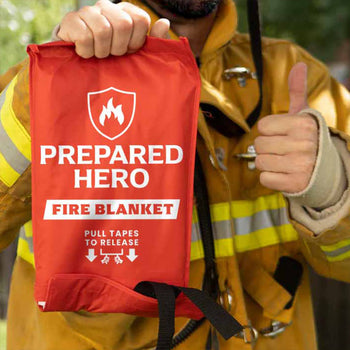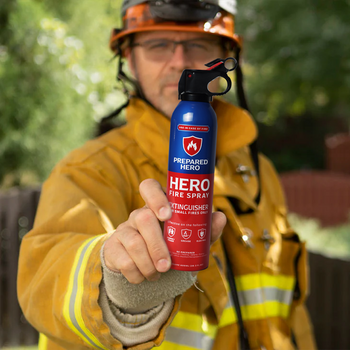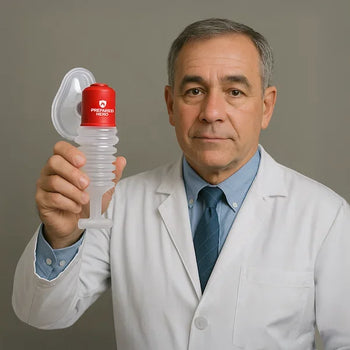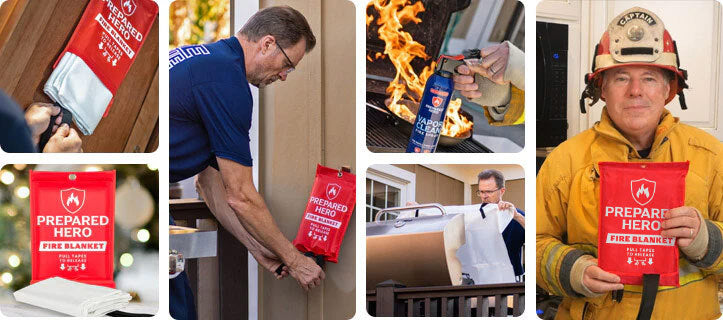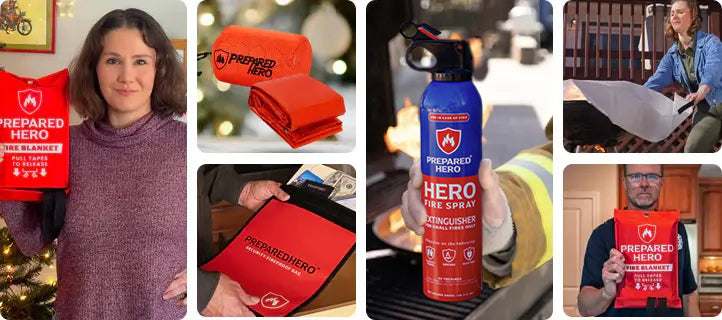Where you put your smoke detectors matters just as much as installing them. Proper placement makes sure they can detect...
An ABC fire extinguisher is a must-have tool for any home or workplace. Whether you're dealing with a small kitchen fire or an office mishap, this extinguisher has your back. It works on many types of fires.
But, like with anything, there are limits to what it can handle. In this guide, we'll talk about the basics of ABC fire extinguishers, how they work, and when to use them. Plus, we'll explore alternative fire safety tools that are just as handy in an emergency.
What Is an ABC Fire Extinguisher?

An ABC fire extinguisher is a multi-purpose tool used to put out different types of fires. It's ideal for homes and businesses because it works on many fire scenarios. The extinguisher contains a dry chemical powder, usually monoammonium phosphate. The powder messes with the chemical reaction that fuels the fire, smothering it, and preventing it from spreading.
ABC fire extinguishers have a pull-pin design and a nozzle that directs the powder where it’s needed. They’re built to handle high pressures, making them reliable during fire emergencies. The cylinders are often made from durable steel, so they can withstand tough environments and last long.
ABC extinguishers come in various sizes, so you can choose one based on your needs. Smaller units are perfect for cars or homes, while larger ones are suited for workplaces and industrial settings.
How Does an ABC Fire Extinguisher Work?

ABC fire extinguishers use a special dry chemical agent called monoammonium phosphate. When used, the powder gets released onto the fire. The powder works in two ways: it cuts off the oxygen supply and cools the burning material. It’s like putting a lid on the fire, which chokes and reduces its temperature.
In addition, the dry chemical softens and sticks when in contact with hot surfaces. As a result, it forms a coating that smothers and isolates the fuel from the air. The powder also reacts when heated, which helps cool the fire further. This makes ABC extinguishers effective for many fire types. While they’re useful in many situations, ABC fire extinguishers aren’t suitable for fires involving metals, cooking oils, or fats. The agent can also be harmful to breathe in, so they’re best for open spaces or areas.
Can an ABC Fire Extinguisher Be Used on All Fires?

No, an ABC fire extinguisher can’t be used on all fires. They can’t be used on Class D (metal) and Class K (grease) fires. They can only be used on Class A, Class B, and Class C fires.
Class A, B, and C fires are the common ones you’ll run into at home or in the workplace. ABC fire extinguishers use a dry chemical that breaks the chemical reaction. However, Class D and Class K fires are different.
Class D fires involve burning metals like magnesium or titanium. These metals burn at extremely high temperatures and react with the chemicals in an ABC extinguisher. Using one on a Class D fire can make the situation worse or cause an explosion.
Class K fires are another issue. ABC fire extinguishers aren’t designed for this kind of fire because they can spread the oil and cause an explosion. Grease fires need Class K fire extinguishers, fire sprays, or fire blankets. They’re designed to put them out without splashing the oil around.
What Is an ABC Fire Extinguisher Used For?

ABC fire extinguishers are a must-have fire safety tool for any home or workplace. They’re designed to handle a range of fire emergencies. Curious what they’re used for? Let’s take a look below:
Class A Fires
Class A fires involve everyday materials like wood, paper, fabric, and plastics. These fires often start in homes, offices, or outdoors. Examples include a candle tipping onto wooden furniture or a campfire igniting dry grass. These fires can spread quickly and are dangerous because they consume nearby items and release toxic smoke.
ABC fire extinguishers work on Class A fires by coating the burning material and cutting off its oxygen supply. Fires need oxygen to keep burning. By creating this barrier, the extinguisher effectively smothers the flames. The powder also cools the surface of the burning item, which lowers its temperature and prevents it from reigniting.
Class B Fires
Class B fires involve flammable liquids and gases. These include gasoline, diesel, alcohol, cleaning products, butane, and propane. Class B fires start from spills, leaks, or improper storage near heat sources. For example, a fire can break out if gasoline spills and a spark ignites. Class B fires spread quickly and produce intense heat. They can occur at home, in workplaces, or industrial settings.
ABC fire extinguishers put out Class B fires by interrupting the chemical reaction fueling the fire. When used on a Class B fire, the powder smothers the flames and prevents oxygen from reaching the fire. This stops the fire from spreading or reigniting.
Class C Fires
Class C fires are caused by electrical equipment. These fires can start from faulty wiring, overloaded outlets, or malfunctioning appliances. They spread fast and are tricky to spot because wires might be hidden behind walls. Find out what an electrical fire smells like here.
ABC fire extinguishers are perfect for Class C fires because they won’t electrocute you. Since water can’t be used on electrical fires, the dry chemical agent smothers the flames without conducting electricity.
When Should You Not Use an ABC Powder Fire Extinguisher?

Class D Fires
ABC fire extinguishers are not designed for Class D or metal fires. Combustible metals don’t react like everyday combustibles. Instead of just catching fire, they burn at extremely high temperatures and can react violently with common extinguishing agents like water or some chemicals.
The dry chemical in an ABC extinguisher is usually monoammonium phosphate. It’s ineffective for metal fires because it can’t smother the flames or reduce the temperature enough. You need a Class D fire extinguisher with a dry powder like sodium chloride or graphite, which forms a barrier that isolates the burning metal from oxygen.
Class K Fires
Class K or grease fires involve vegetable oils or animal fats. Grease fires usually start in kitchens. They burn differently because they retain a lot of heat. Using an ABC extinguisher here can cause the hot grease to splash, spread the fire, and cause injuries.
Class K fire extinguishers use wet chemical agents that react with the grease to form a soapy layer. The layer then cools the fire and prevents it from reigniting. The monoammonium phosphate in ABC extinguishers doesn’t cause this reaction, so it’s ineffective against grease fires. Check out how to put out a grease fire here. You can also check how fire blankets work on grease fires here.
How to Use ABC Fire Extinguishers

Using an ABC fire extinguisher might look tricky, but the PASS fire extinguisher method makes it easy. Here’s how to use an ABC fire extinguisher step-by-step:
1. Pull the Pin
Turn off the power first if you’re dealing with a Class C fire. If you’re dealing with a Class A or B fire, start by pulling the safety pin. Some extinguishers may have tamper seals, so remove them before pulling the pins.
2. Aim at the Base
Next, point the nozzle or hose at the base of the fire, not the flames. The fire burns from the fuel at the bottom, so targeting that area puts it out faster.
3. Squeeze the Handle
Gently squeeze the handle to release the dry chemicals. Use steady, controlled pressure to keep the flow consistent. Don’t squeeze too hard or too fast because this can waste the extinguishing agent.
4. Sweep From Side to Side
Move the nozzle from side to side. Start from a safe distance and move closer as the fire gets smaller. Keep spraying until the fire is completely out and the area is cool.
Remember, you and your loved ones are the priority. Only use ABC extinguishers on manageable fires. A small flame can turn into a major fire in 30 seconds, so be careful. If the fire spreads quickly or you feel unsafe, evacuate and call for help immediately.
Will an ABC Fire Extinguisher Put Out a Grease Fire?

No, an ABC fire extinguisher won’t put out a grease fire. In fact, using one can make it worse. ABC extinguishers use a dry chemical that can spread the burning grease and cause an explosion.
Use a Class K fire extinguisher, fire blanket, or fire spray instead. They’re designed to quickly put out grease fires and prevent them from reigniting. Just remember, never use water on a grease fire because it can make the flames explode.
ABC Fire Extinguisher Alternatives
While ABC fire extinguishers help, they can be expensive, heavy, and hard to store. They might also leave a mess that’s hard to clean up.
A fire spray is an easy-to-use, lightweight, and affordable alternative to ABC fire extinguishers. Prepared Hero’s fire spray is also biodegradable and non-toxic. Unlike an ABC fire extinguisher, you can safely use it around your family and pets.
Here’s a table summarizing the differences between Prepared Hero’s fire spray and a regular ABC fire extinguisher:
| Prepared Hero’s Fire Spray | Regular Fire Extinguisher |
| Lightweight, easy to carry | Heavy, hard to carry |
| Affordable | Expensive |
| Easy to store | Needs more space for storage |
| 100% biodegradable | Mostly made of non-biodegradable materials |
| Non-toxic | Can be Toxic |
| Easy to clean | Hard to clean |
| Safe for kids and pets | Not safe for kids and pets |
Another alternative is a fire blanket, which depletes the fire’s oxygen supply. By doing this, it puts out small Class A, B, and C fires in seconds. It also doesn’t leave a mess because it simply covers the fire.
Unlike ABC fire extinguishers, Prepared Hero’s fire blanket doesn’t expire. You can reuse it as many times as you want as long as it’s not damaged. Plus, you can use it to save someone on fire.
Here’s a table summarizing the differences between Prepared Hero’s fire blanket and a regular ABC fire extinguisher:
| Prepared Hero’s Fire Blanket | Regular Fire Extinguisher |
| Lightweight, easy to carry | Heavy, hard to carry |
| Affordable | Expensive |
| Doesn’t expire | Expires |
| Easy to store | Needs more space for storage |
| Non-toxic | Can Be Toxic Because of Additives |
| Doesn’t leave a mess | Leaves a mess |
| Safe for kids and pets | Not safe for kids and pets |
| Can be used on humans | Can’t be sprayed on humans |
Do you want reliable, easy-to-use, and affordable tools to put out small fires before they become raging infernos? Check out Prepared Hero’s fire prevention tools here, and get up to 51% off on certain items. Stay prepared, hero!


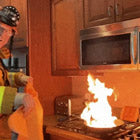 Fire
Fire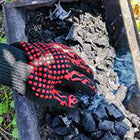 Safety
Safety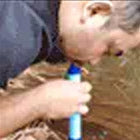 Survival
Survival Protection
Protection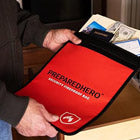 New
New
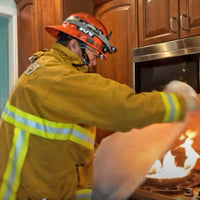 Fire
Fire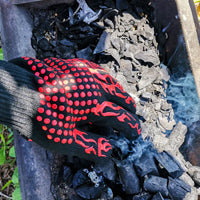 Safety
Safety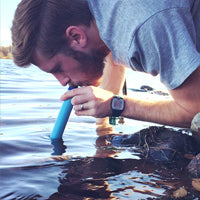 Survival
Survival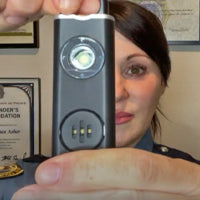 Protection
Protection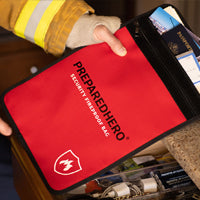 New
New
